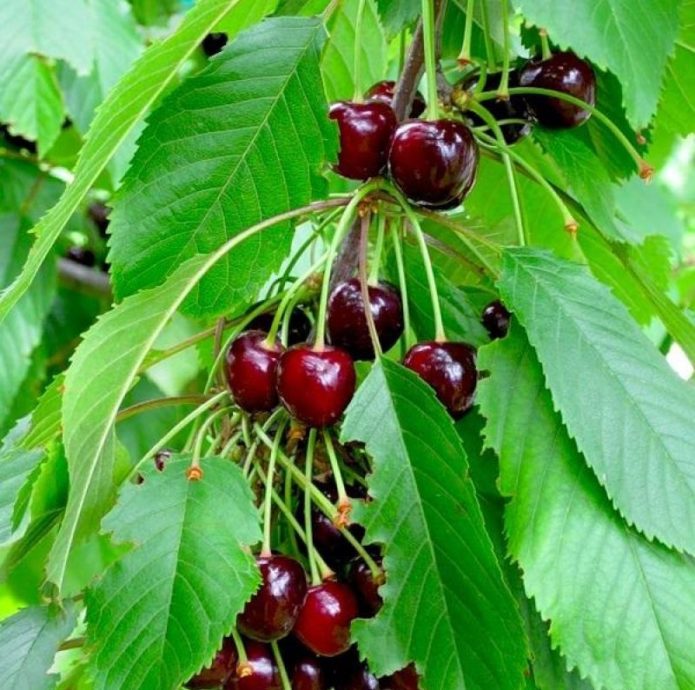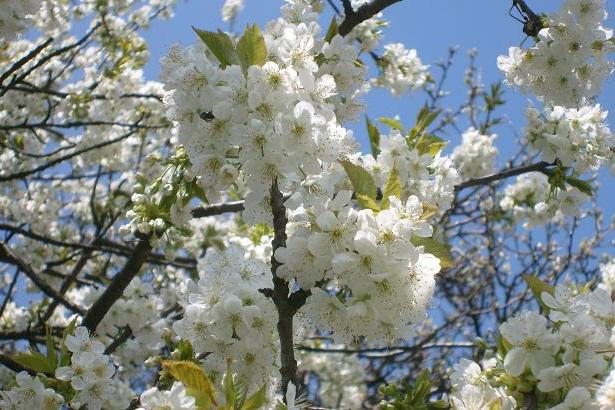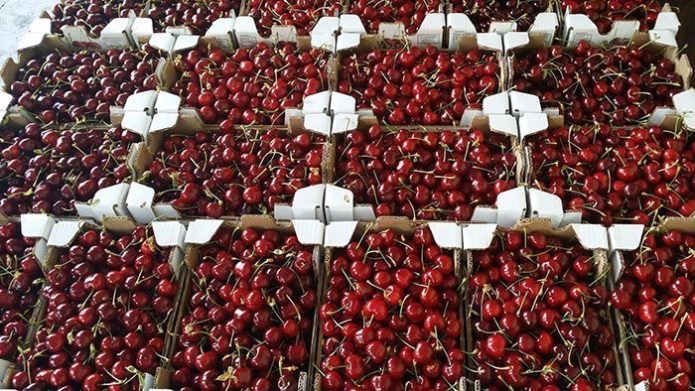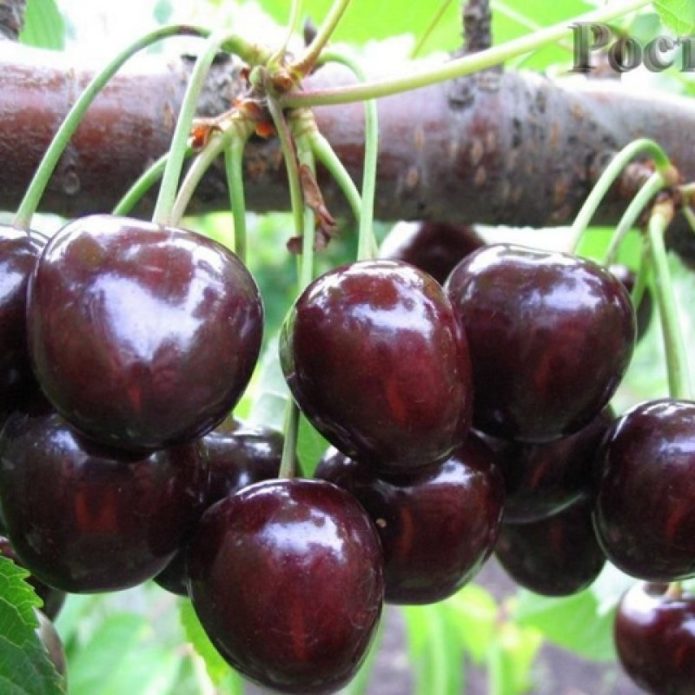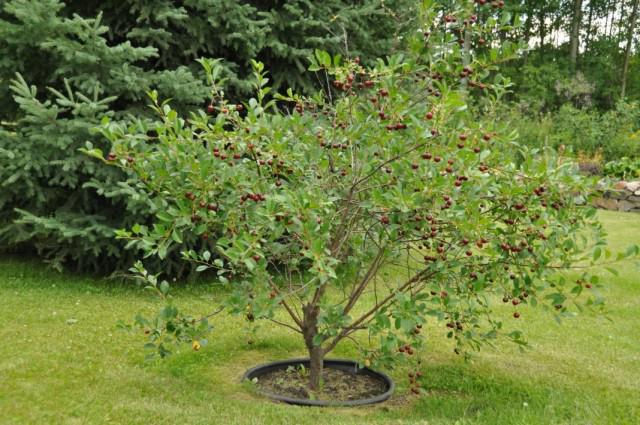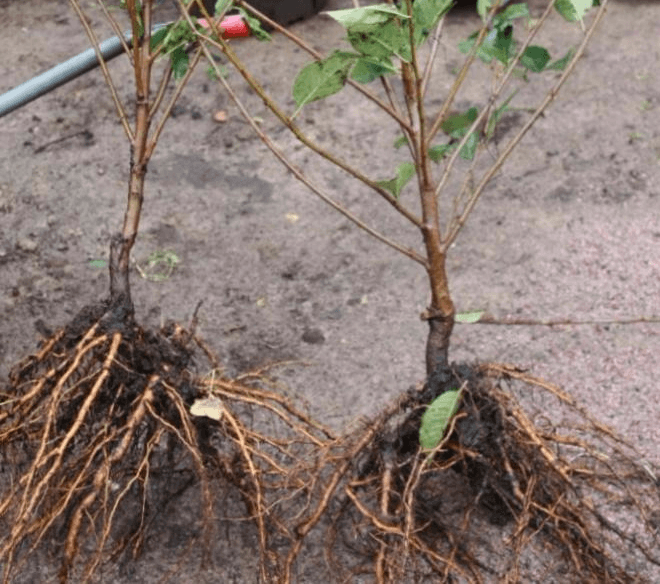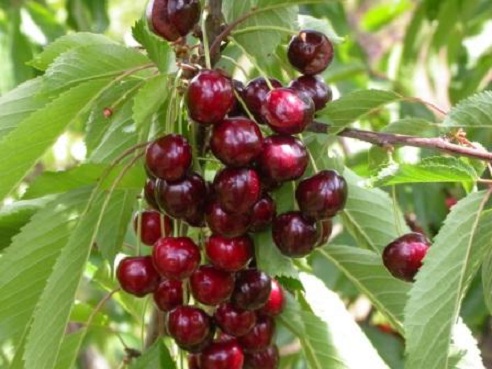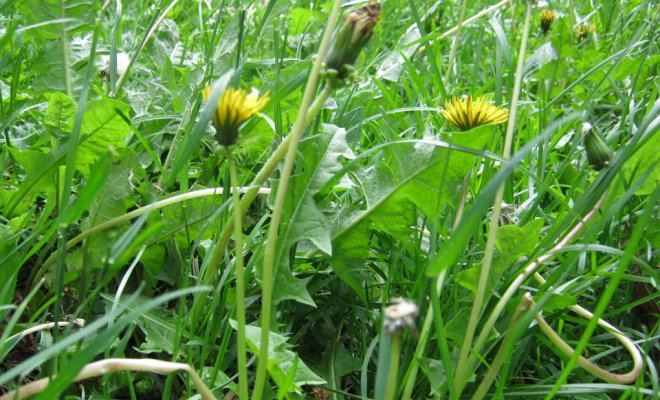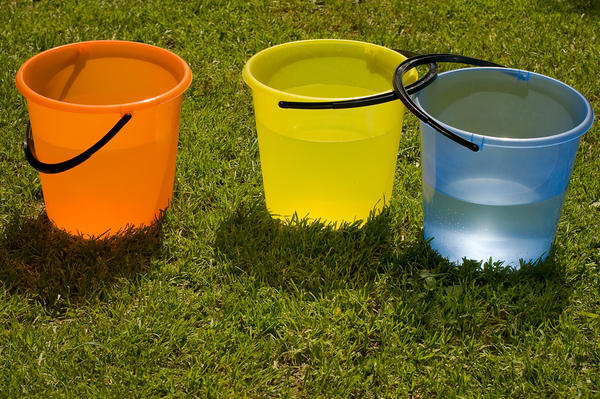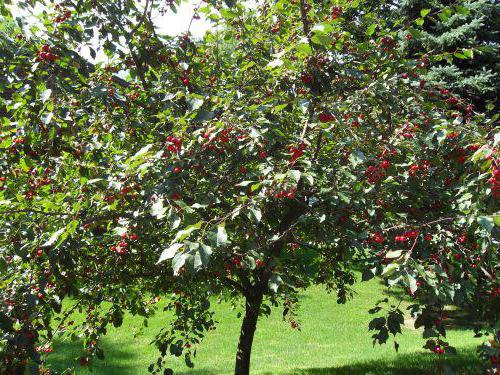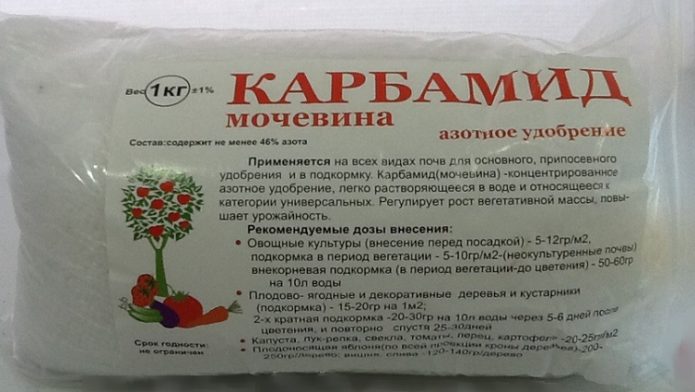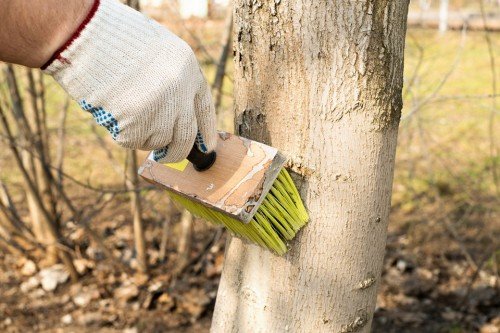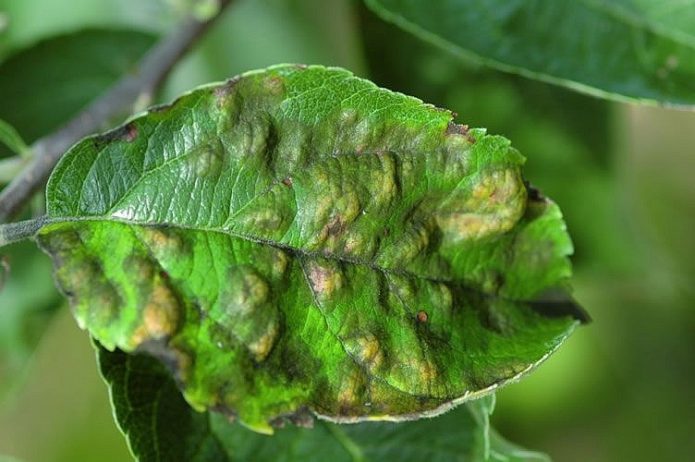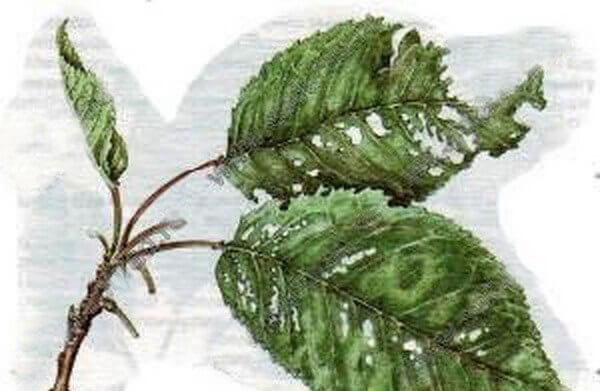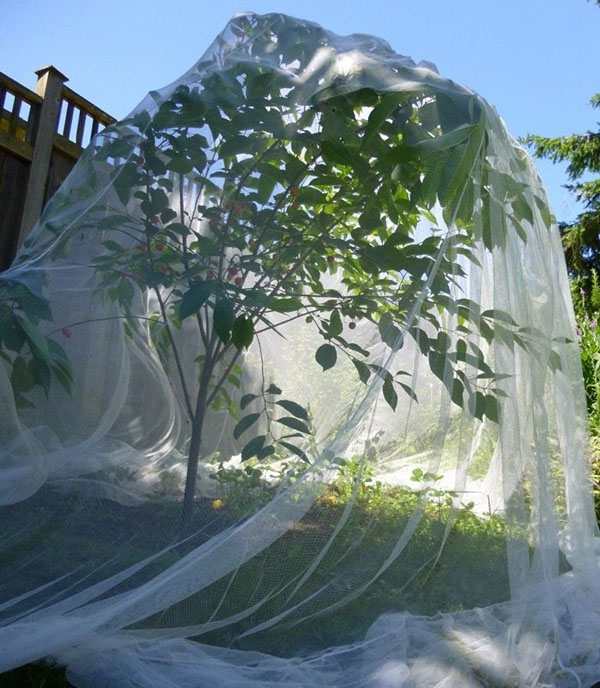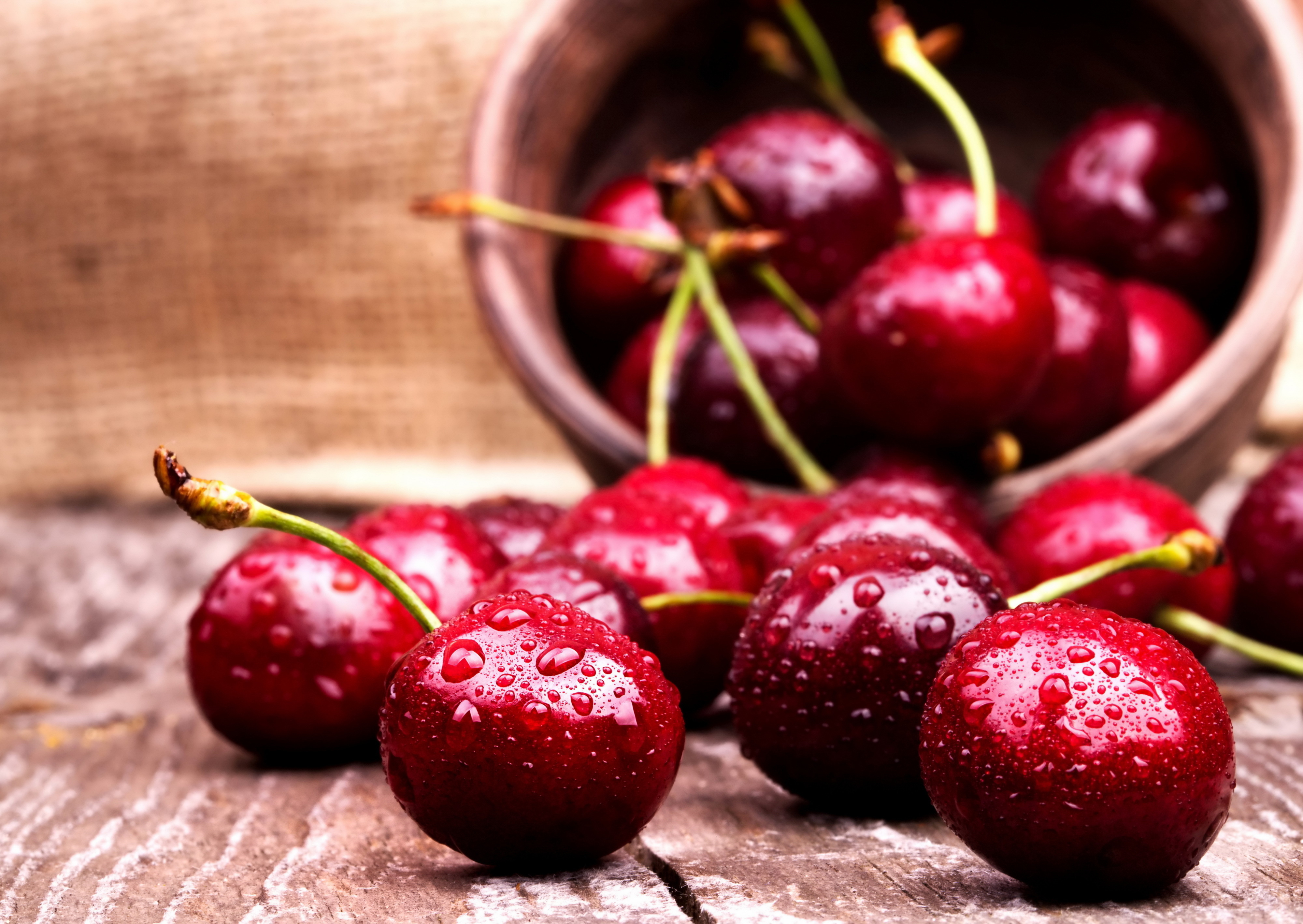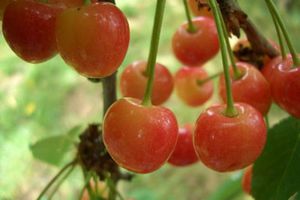Cherry Ovstuzhenka is extremely hardy and frost-resistant, making it suitable for cultivation in severe weather conditions in the middle zone. The variety is considered young, therefore it is not very common, but every year more and more trees are planted in the south and in the center of Russia.
Content
History of origin
At the All-Russian Research Institute of Lupine in Bryansk, thanks to the activities of the biologist M.V. Kanshina got a cherry variety called Ovstuzhenka. The culture was the result of combining two varieties of cherries: Compact Venyaminov and Leningrad black. In 2001, Ovstuzhenka was entered into the State Register of Breeding Achievements of the Central Region. The variety is suitable for cultivation in the Bryansk, Vladimir, Ivanovo, Kaluga, Moscow, Ryazan, Smolensk, Tula regions.
Description of the variety
The tree grows rapidly, but reaches a small size. The leaves form a dense crown, which rises slightly and takes on a spherical shape. Straight branches glabrous, without pubescence, brownish brown. Large ovoid leaves are round at the base and sharp at the top. The edging of the sheet plate with double serrated serration. The surface of the leaf blades is flat, smooth, with a matte sheen.
Bloom
Cherry blossoms early - in the second decade of May. The inflorescences consist of three large snow-white flowers, which are collected from petals that go behind each other. The rim is shaped like a saucer. The pistil stigma is at the same level with the long stamens or slightly higher. Sepals are slightly pigmented. About 60% of fruit ovaries appear on bouquet branches.
Flowers tolerate frost well.
Fruiting
In regions with a warm climate, the fruits ripen in mid-June, and in the Trans-Urals - 30 days later. Young plants begin to harvest from the 4th to 5th year of life. You can even pick a basket of sweet berries from a 40-year-old tree.
Sweet cherry Ovstuzhenka is considered a high-yielding crop, although young plants are not very productive and yield an average of 15 kg per tree. The highest yield is 30 kg.
The berries are large, oval or rounded, characterized by a deep dark red color that seems almost black. Average weight - 4 g. Especially large fruits weigh 6–7 g.
The bones are easily calcined from the pulp. Heavy rainfall and wet seasons do not cause the fruit to crack. The dense pulp and juice are colored in a rich dark red hue. The fruit tastes very delicate and sweet. The tasting score ranges from 4.5 to 4.7 points out of 5.The variety is universal, that is, cherries are consumed fresh and used to make compotes, jams and other homemade preparations.
Collection and storage of berries
The fruits are harvested when they are ripe. It is better to tear them off together with the stalk, so they will painlessly tolerate transportation and will be well preserved. This technique seals the juice inside the berry and prevents it from being released prematurely. The fruits, even in a ripe state, retain their rigidity, so the collection container can be filled to the top, without fear that the upper specimens will crush the lower ones.
If you find injured fruits in the container, urgently isolate them so that they do not spoil healthy ones. You can store berries for 5-6 days in a place with high humidity and temperature no higher than 4aboutFROM.
Since the berries of this variety appear one of the first, they are considered an excellent source for replenishing the lack of beneficial trace elements after spring vitamin deficiency. Sweet cherry is popular among adherents of traditional medicine. It is used to treat the kidneys, the fruits tone the body, help with weight loss and improve health indicators.
Advantages and disadvantages
The disadvantages of the variety are a low percentage of self-pollination. The pluses are much more numerous:
- large juicy fruits with a sweet taste;
- low trees (it is convenient to look after the plant and pick berries);
- preservation of a presentation after transportation;
- frost resistance (up to -45aboutFROM);
- fruits do not crack even after heavy rainfall;
- long life span;
- high stable fruiting;
- excellent survival rate of the seedling;
- resistance to diseases (for example, to coccomycosis and monilosis).
Growing features
A rich harvest and sweetness of the fruit depends on cultivation conditions and diligent care. Ovstuzhenka grows into a large fruit-bearing tree, subject to certain nuances.
Choosing a place and time of landing
In regions with cool weather, Ovstuzhenka is planted in spring, until the buds swell. In the south and in the middle lane, you can do this in October. In the spring, they begin planting immediately after the ground thaws. Although the variety is winter hardy, it needs an area that is not blown by northern winds. A place is suitable between outbuildings (house, bathhouse, barn, fence).
The place in the garden intended for Ovstuzhenka should be well lit by the sun's rays. The ideal site is a slope in the south or southwest. In the shade, cherries will bear less fruit. The tree is planted on a site with a hill.
If it is not possible to find such a place in the country, a hill is created artificially, raising the soil level by 0.5 m.
Ostuzhenka grows well on sandy loam and loamy soils with neutral acidity. Groundwater should not approach the surface closer than 1.5 m. You cannot choose a place that is flooded and holds water for a long time. Sweet cherries will grow slowly in sandy, clayey and peaty soils. However, it can be planted in such soil, adhering to certain rules: when planting in sandy soil, 2 buckets of clay are added to the hole, and the same amount of sand is added to the clay soil.
Selection of seedlings
To buy a crop, you should choose a nursery with good reviews. On sale are mainly seedlings 1–2 years old with an open root system.
When choosing, the plant is carefully examined, assessing the condition of the buds, bark and roots. The seedling should have a central trunk and many branches. It is such a tree that will develop a lush crown with good branching in the future. Without a strong main conductor, cherries may break under the weight of the berries in the future. Pay attention to the vaccination site: it must be clearly visible. This is the first sign of a varietal crop. Before purchasing, ask about the type of rootstock.Keep in mind that seed stocks are preferable, as they grow strong and hardy trees.
If you purchased a seedling in the autumn, and you are going to plant in open ground in the spring, dig it into a hole of shallow depth at an angle of 45about... Lay the tree with the top pointing south. Sprinkle the roots with earth and the branches with sand. With the onset of winter, the tree is covered with snow.
Planting process
If the tree is planted in the spring, then the soil is prepared in the fall, and if in the autumn months, then 2 weeks before planting. Dig a hole 80 cm wide and 1 m deep. A nutrient mixture of 1 kg of potassium sulfate, 3 kg of superphosphate, 1 kg of ash, 2 buckets of earth and 30 kg of compost or manure are placed on the bottom. This mixture should take up one third of the hole.
The dried roots of seedlings are left for 10 hours in water at room temperature before planting.
Sequence of actions for landing:
- A peg made of wood is placed in the hole, which is necessary as a support for a young seedling.
- From the ground located in the hole, a mound is built on which the plant is installed.
- The root system is carefully straightened, the root collar is placed 5–6 cm above the surface.
- The roots are covered with earth, periodically shaking the tree so that all voids are filled.
- The soil is tamped.
- 0.5 m retreat from the seedling and build a hole for irrigation, where 20 liters of water are poured.
- The trunk circle is covered with straw or peat.
- The seedling is tied to a peg.
When planting is complete, the plant is pruned for the first time. They choose 3-4 strongest and healthiest branches, and get rid of others without forming stumps. The trunk is shortened so that it is 20 cm higher than all other branches.
Pollinators
The variety is semi-fertile. However, one should not rely on the self-pollination of the variety, because it is very low - about 5%. For this reason, the amount of the crop is increased by planting pollinators. The best in this case are:
- Iput;
- Jealous;
- Tyutchevka;
- Pink pearls;
- Raditsa;
- Bryansk pink.
If there is not enough space in the garden and there is no way to plant another cherry-pollinator plant, gardeners resort to trick, grafting a branch of one of the varieties recommended for pollination onto the Ovstuzhenka tree.
Care
The soil around the trunk should always be clean, that is, other crops, including weeds, should not grow on it. The circle located in the area of the trunk must not be poured with concrete or covered with a sheet of metal. In the first year of growth, it is recommended to remove all flowers on the tree. This procedure will help the early adaptation of the plant. In the following seasons, the harvest is also controlled by cutting off half of the greenfinches. This helps to get large sweet berries in the future.
Watering
Moisten the soil under the cherries once a week. Watering is especially important in May and June when the fruits are poured. If at this time the tree does not have enough water, this will affect not only the harvest of this year, but also the fruits of the next season. Watering is finished in July, when the berries are fully ripe, otherwise the development and growth of the branches may continue, and then the cherries will suffer in winter.
For one watering, 15–20 liters of water are consumed per tree. One day after the soil is moistened, it is loosened to a depth of 8–10 cm. The same should be done after rain. 2 weeks before frost, water-charging irrigation is carried out - this will require 60–70 liters of water. Watering in autumn is essential for successful wintering.
Pruning
Every year, it is imperative that pruning is carried out so that the crown takes the correct shape and receives sunlight evenly. The procedure allows you to adjust the yield level, the size of the berries and their taste. At the first planting, the seedling is cut at a height of 1 m so that the crown forms and develops faster.
Shoot length is adjusted at the beginning of spring, until the buds are laid. If the tree is growing too much, pruning of young branches in August is allowed. Before winter comes, the remaining shoots can become thicker and adapt. The branches reaching the ground are shortened.
Thinning is carried out every year, removing twisted, weak and damaged branches. Only straight and strong shoots are left on the tree. Places of cut and damage to the bark are lubricated with garden pitch.
Garden var is prepared from 250 g of solid oil, 200 g of wax and 50 g of resin. All components are first melted and then mixed.
Top dressing
The tree is fed from the second year of life. Urea acts as the first feeding. In early spring, 100 g of funds are scattered around the trunk, after which they are covered with earth and watered. In spring, cherries are provided with fertilizers with nitrogen, and in autumn - with superphosphate and potassium sulfate. Also, throughout the growing season, they are regularly fed with organic fertilizers. If the tree is growing on nutritious soil, it is important not to add excess. The poor soil is enriched every year.
Preparing for winter
Despite its resistance to frost, Ovstuzhenka must be prepared for winter. First, the trunk is whitewashed to scare off parasites and protect the plant from the effects of low temperatures. For better resistance to frost, the soil around the tree is mulched (with sawdust or peat) with a layer of 20 cm, and the trunk is wrapped with a covering material that allows water and air to pass through (burlap, paper). This will protect the tree from mice and hares.
Video: caring for cherries
Diseases and pests
Ostuzhenka is quite resistant to various diseases, however, the gardener may have problems with it. If the cherry is affected by scab, the leaves become dark and curl, and the berries stop growing and dry. In order to avoid the development of scab during the laying of buds, the plant is treated with copper oxychloride. In autumn, the leaves are removed and the soil is dug up.
In some cases, a brown spot develops on the tree. Dark spots appear on the leaves, transforming into holes. They treat a garden tree by treating with a Bordeaux mixture. Preventive measures include timely pruning of the tree and removal of diseased and old branches. The cut site is treated with copper sulfate. At the beginning of spring, the soil around the trunk is sprayed with the same agent.
Mosaic disease is characterized by the appearance of yellowish stripes on the leaf blades. Leaves curl and dry. If the cherry is struck by this disease, the tree is dug up.
Sometimes cherries become ill with gum flow. Gum is released on the trunk. Get rid of the disease by removing this substance and treating the affected areas with copper sulfate.
Birds love to feast on cherries. It is not difficult to save the harvest from them, you just have to hide the crown of the tree under a net or other light material.
Variety reviews
I personally have 3 cherries growing on the site. For some reason, I count on Ovstuzhenka more. It looks more like a "northern" cherry, does not grow so rapidly, which means it will have time to prepare the branches of summer growth for winter, that is, the branches will become lignified in time, the buds will form and winter normally.
I have one of the cherries this year (Ovstuzhenka) tied the fruits very tightly, now it is neither alive nor dead, depressed, with small tasteless fruits ... Does not pull, grafted on a cherry rootstock, the rootstock is 1.5 times thinner than the scion, it will have to be adjusted with the crown next spring.
The best varieties for the Moscow region are Iput, Bryanskaya rozovaya and Ovstuzhenka. Iput is a pollinator for Bryansk Rose and Ovstuzhenka, and these two are for Iput. If you plant all three - the harvest will be hoo.
The berries of the Ovstuzhenka variety make amazing compotes and jams. You can eat fresh cherry fruits. They contain a large amount of nutrients that our body needs. Plant a wonderful Ovstuzhenka in your garden - the result will meet expectations.
